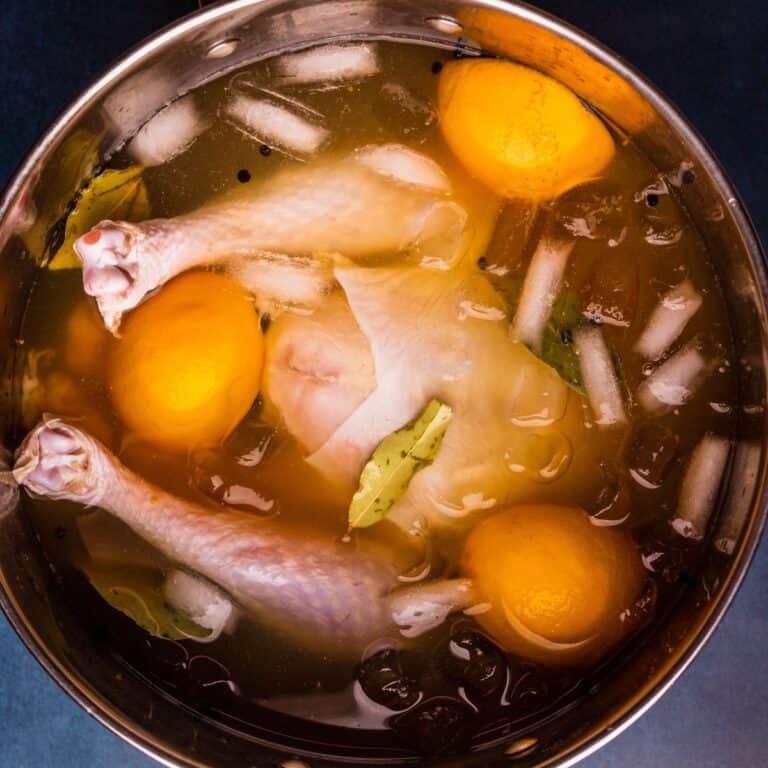
Are you ready to take your turkey from ordinary to extraordinary? The secret is in the brine! This Overnight Thanksgiving Turkey Brine is made with apple cider and ginger beer, which not only locks in moisture but also infuses your bird with incredible flavor!
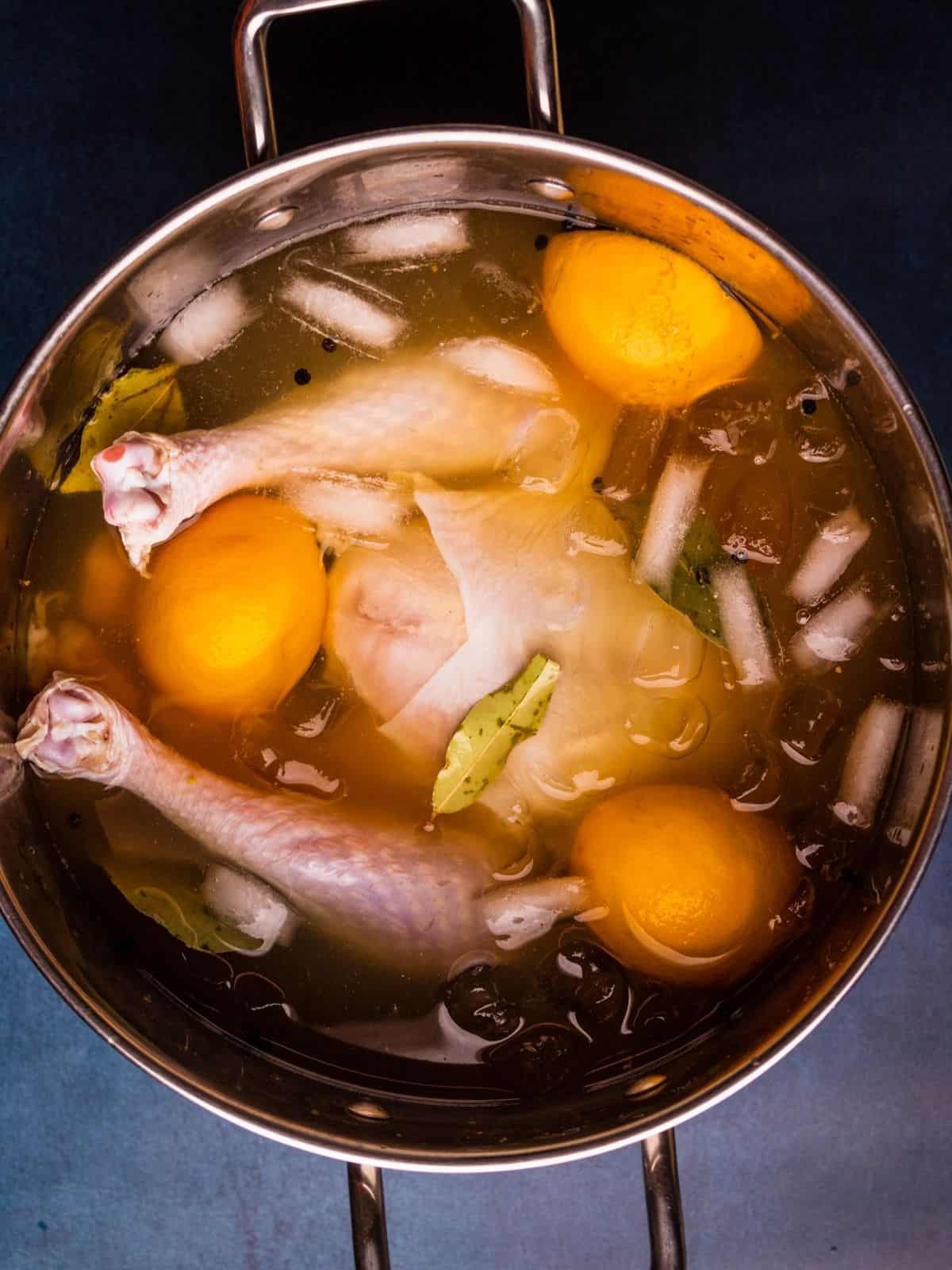
Brining is a game-changer when it comes to creating the best-tasting turkey. I started using this method several years ago, and it turned my turkey-hating husband into a Thanksgiving Turkey lover!
It gives you perfectly seasoned turkey that’s moist, tender, and flavorful—no dry, bland bird here! Trust me, your family and holiday guests will love it.
Jump to:
- 🤔 Is Brining a Turkey Worth It?
- 📘 Glossary
- 🦃 Dry vs. Wet Turkey Brine
- 📕 Ultimate Thanksgiving Guide
- 🤓 What is the Best Formula for a Wet Turkey Brine?
- 🍎 Ingredients for Homemade Thanksgiving Turkey Brine
- 👩🏻🍳 How to Overnight Brine a Whole Turkey
- ⭐ Chef's Secret
- 📖 How to Cook a Brined Turkey
- ⏲️ Times and Temperatures for Roasting Turkey
- 💭 Frequently Asked Questions
- 🦃 Thanksgiving Recipes
- 📱 #ScarlatiFamilyKitchen
- 📖 Recipe
- 💬 Comments
🤔 Is Brining a Turkey Worth It?
The short answer is yes. The brining process works by soaking the bird in a flavorful mixture of salt, sugar, and seasonings, which helps it absorb moisture and flavor.
Salt plays a crucial role by breaking down muscle proteins, allowing the turkey to hold onto more water during roasting. This ensures the meat stays juicy, even in the breast, which tends to dry out quickly.
📘 Glossary
If you don't recognize a tool or skill I mentioned, you can look it up in my Glossary of Cooking Terms and Definitions for more information!
🦃 Dry vs. Wet Turkey Brine
Both dry and wet brines are excellent ways to ensure a juicy, flavorful turkey, but they work differently.
A dry brine uses the turkey's natural moisture to create a concentrated brine on the surface of the meat. The salt draws out those juices, mixes with them, and reabsorbs back into the turkey. This process infuses flavor and breaks down the muscle proteins, helping the meat retain moisture during cooking.
In a wet brine, the turkey is submerged in a salt-infused water solution. This method allows the meat to absorb extra liquid along with the flavors in the brine. The salt helps the turkey hold onto that moisture during roasting, giving you a plump, juicy bird.
Both methods have their perks, and choosing the right one depends on your preferences and the tools you have on hand!
Once you've decided on a wet brine, here's how to create the perfect formula.

📕 Ultimate Thanksgiving Guide
Plan and host a stress-free Thanksgiving dinner with this Ultimate Thanksgiving Guide filled with 30+ pages of checklists, schedules, planners, and more!
🤓 What is the Best Formula for a Wet Turkey Brine?
The standard formula for a wet turkey brine starts with 4 quarts of water to 1 cup of kosher salt. Instead of just water, I opt for adding apple cider, vegetable broth, ginger beer, and freshly squeezed oranges, along with ice water, to give the turkey even more flavor.
🍎 Ingredients for Homemade Thanksgiving Turkey Brine
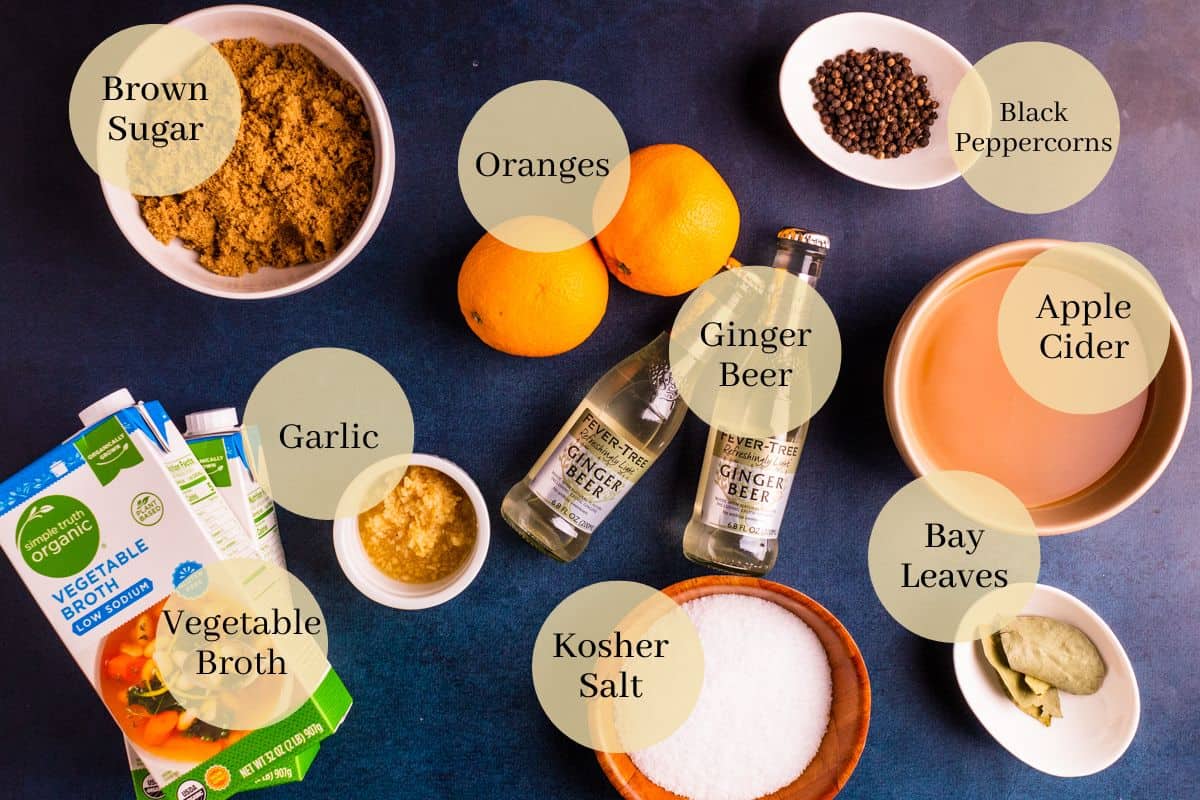
- Liquid - Apple cider, vegetable broth, ginger beer, squeezed oranges, and ice water are used in this brine to infuse both flavor and moisture. It may seem excessive, but trust me, it’s the best combo.
- Sugar - Brown sugar is mostly used for flavor, but it can also help with browning during the cooking process.
- Salt - All you need here is standard kosher salt. This specific type of salt dissolves evenly and quickly in the liquid and will help draw out the moisture in the turkey the best.
- Aromatics - To give the turkey additional flavor, garlic, whole black peppercorns, and bay leaves are added to the brine mixture.
👩🏻🍳 How to Overnight Brine a Whole Turkey
Defrost the Turkey - Allow 3–5 days for the turkey to fully defrost, depending on its size. Plan ahead to ensure it’s thawed completely before brining.
Get the Container - Find a clean container large enough to hold the whole turkey plus approximately 2 gallons of liquid. I make the brine in a large stock pot and then add the turkey to it for brining. A brining bag, 5-gallon cooler, or other container can also be used. (Make sure this container fits in your fridge—or garage if it’s cold enough where you live!)
Make the Brine - In a large pot, combine the apple cider, brown sugar, kosher salt, garlic, peppercorns, bay leaves, vegetable broth, and ginger beer. Squeeze as much juice from the orange halves into the pot and then add the squeezed orange halves to the mix.
Bring the mixture to a boil over medium-high heat and cook for 5 minutes, stirring occasionally, until the sugar and salt are dissolved. Let this mixture cool completely.
Mix the Brine - Once the brine mixture is cool, mix it with 2 quarts of ice water in the container where you'll brine the turkey. Slowly add the turkey to the container and top it with 2-4 quarts of ice water until covered.
Let the Magic Work - Move the container to the refrigerator and allow it to brine for 16-24 hours. This is best done two nights before roasting to allow time for the next step.
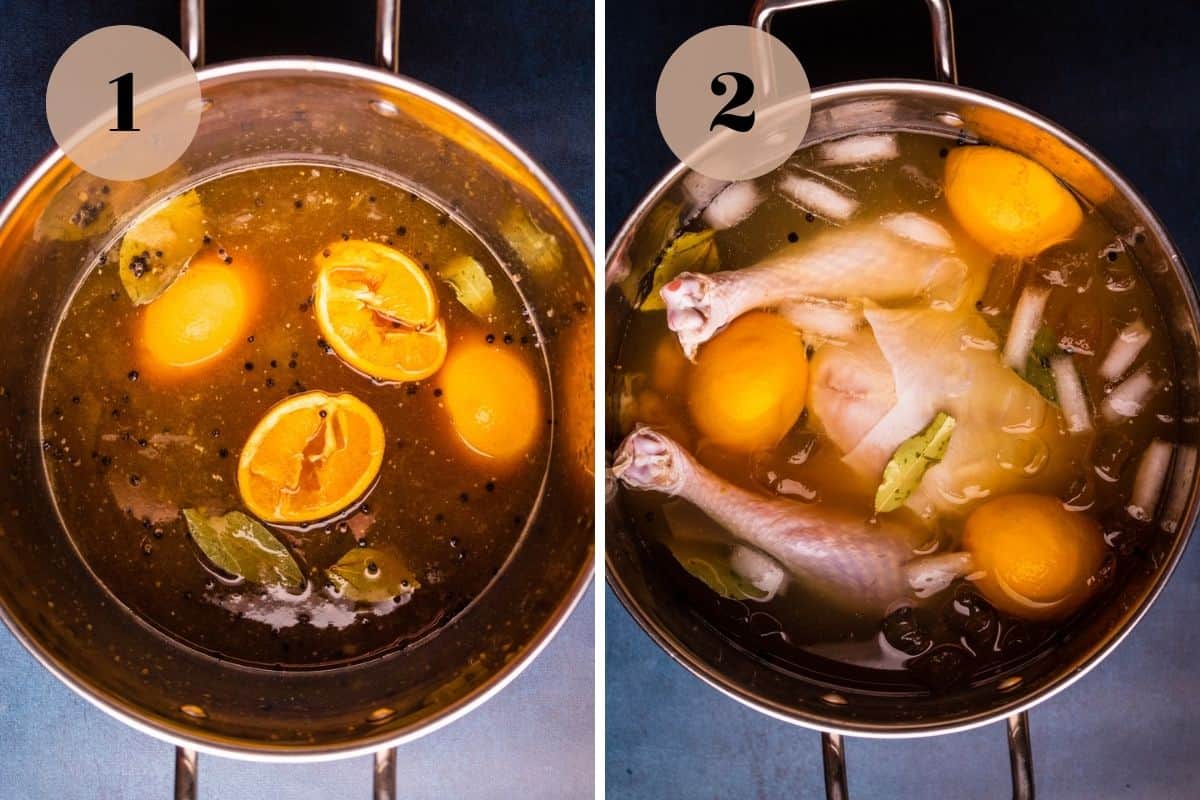
Wash and Dry - Slowly remove the turkey from the brine, allowing it to drain completely. Rinse the inside and outside of the turkey with cool water to remove any excess brine.
Pat the turkey completely dry with paper towels and place it on a sheet pan or roasting pan. Let the turkey sit in the refrigerator uncovered for at least 12 hours to dry. This is best done the night before roasting to allow it to completely dry.
Once your turkey is brined, washed, and dried, you are ready to cook it!

⭐ Chef's Secret
Handling raw meat can get messy, so minimize splashes and drips. Work over a sink or a lined countertop, and sanitize everything thoroughly afterward.
📖 How to Cook a Brined Turkey
Roasting is my favorite method for cooking a brined turkey because it creates a beautifully golden, crispy skin and tender, flavorful meat. This is how I cook my Oven Roasted Turkey for Thanksgiving every year and pairs well with my Apple Cider Turkey Gravy. You can also smoke or deep fry a brined turkey.
If you choose to deep fry, it’s critical to completely dry the turkey, inside and out, before cooking. After patting it dry, let it air-dry in the refrigerator, and check it again before frying. Even a small amount of moisture can react dangerously with the hot oil.
- Initial Roasting - Place the turkey in a roasting pan and cook it uncovered at 350°F for 45–60 minutes, or until the skin turns golden brown.
- Cover with Foil - Loosely tent the turkey with aluminum foil to prevent the skin from over-browning while allowing the interior to cook through. Continue roasting until the internal temperature in the thickest part of the breast and thigh reaches 150°F.
- Add Glaze or Butter - At this stage, I like to brush on a glaze or melted butter to keep the skin moist and help it achieve a beautiful, rich brown color.
- Final Roasting - Return the turkey to the oven, uncovered, and cook for 30–45 minutes until the internal temperature reads 165°F and the skin is deep golden brown.
⏲️ Times and Temperatures for Roasting Turkey
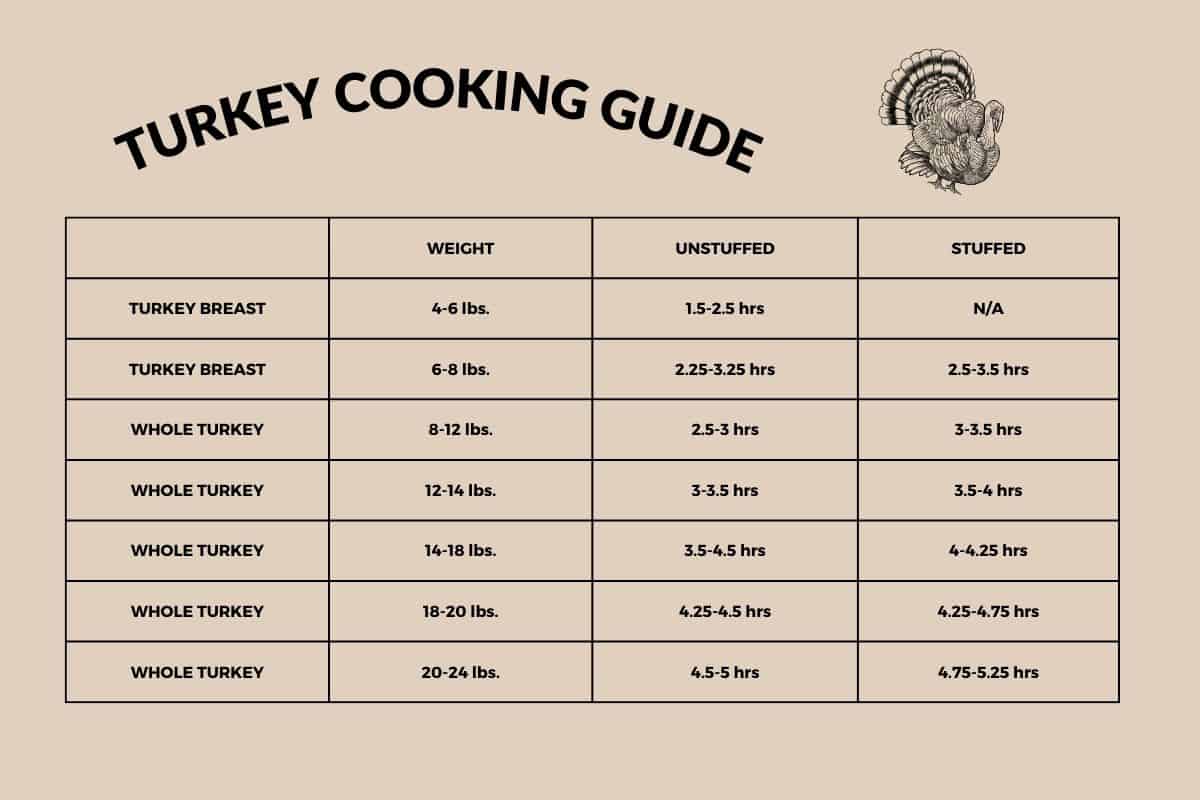
💭 Frequently Asked Questions
I’ll admit, there have been years when my turkey wasn’t fully defrosted before I added it to the brine. While it doesn’t harm the turkey, a frozen bird won’t absorb the brine as effectively. That’s why it’s always best to completely thaw your turkey before brining it for the best results.
Yes, you can over-brine a turkey. It’s important not to let the turkey sit in the brine for more than 24 hours, as the extended time can break down the proteins too much. This can lead to overly salty, spongy meat—definitely not what you want.
Yes, you should rinse your turkey after brining it to remove any excess salt from the skin. While rinsing raw meat isn’t something I typically recommend, it’s necessary to ensure the turkey isn’t overly salty. Rinse carefully to avoid splashing and thoroughly clean the area afterward to maintain kitchen safety.
🦃 Thanksgiving Recipes
For more foolproof Thanksgiving recipes to add to your menu, check out some of my favorites below.
📖 Recipe
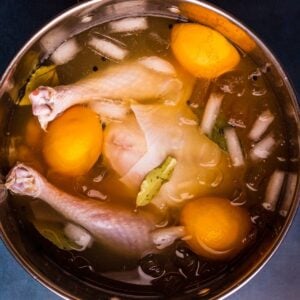
Overnight Thanksgiving Turkey Brine with Apple Cider
Equipment
Ingredients
- 2 cups apple cider
- 1 cup dark brown sugar
- 1 cup kosher salt
- ¼ cup chopped garlic
- 2 Tablespoons whole black peppercorns
- 4 whole bay leaves
- 2 quarts vegetable broth
- 12 ounces ginger beer (affiliate link)
- 2 large oranges, cut in half
- 4-6 quarts ice water, approximately 50/50 ice to water ratio
Instructions
- Allow turkey to thaw in the refrigerator for 5 to 6 days prior to roasting. See my note below for thawing times. Find a clean container large enough to hold the whole turkey plus approximately 2 gallons of liquid. This can be a large stock pot, cooler, or brining bag. Make sure this container will also fit in the fridge while the turkey is being brined.
- Two nights before Thanksgiving, start the brine. In a large pot, combine the apple cider, brown sugar, salt, garlic, peppercorns, bay leaves, vegetable broth, and ginger beer. Squeeze as much juice from the orange halves into the pot and then add the squeezed orange halves.
- Bring the mixture to a boil over medium high heat and boil for 5 minutes, stirring occasionally, until both the sugar and the salt are completely dissolved. Let cool completely.
- Mix the cooled brine mixture with 2 quarts of the ice water in the brining container. Slowly add the turkey to the container and then top with 2-4 quarts of ice water, until the turkey is completely covered.
- Move the container to the refrigerator and allow it to brine for 16-24 hours. This is best done two nights before roasting to allow time for the next step.
- The night before Thanksgiving, remove the turkey slowly from the brine allowing it to drain completely. Rinse the inside and outside of the turkey with cool water to remove any extra brine. Pat it completely dry with paper towels and place on a sheet pan or roasting pan.
- Let the turkey sit in the refrigerator uncovered for at least 12 hours to dry. This is best done the night before roasting to allow the full time for the turkey to dry out.
- Cook the turkey with your desired cooking method.




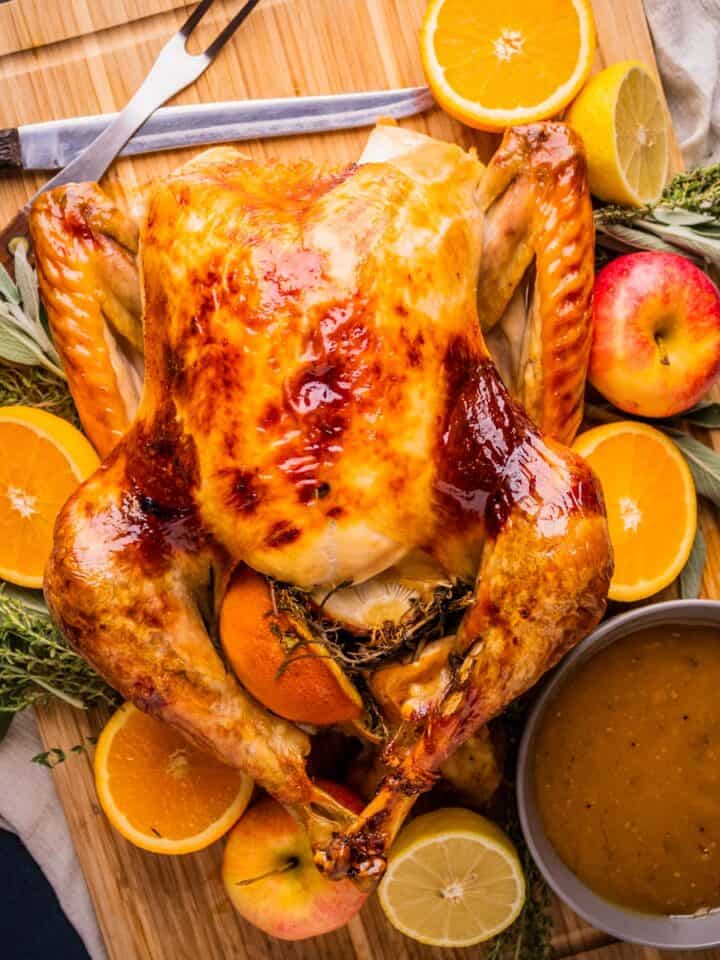

Comments
No Comments